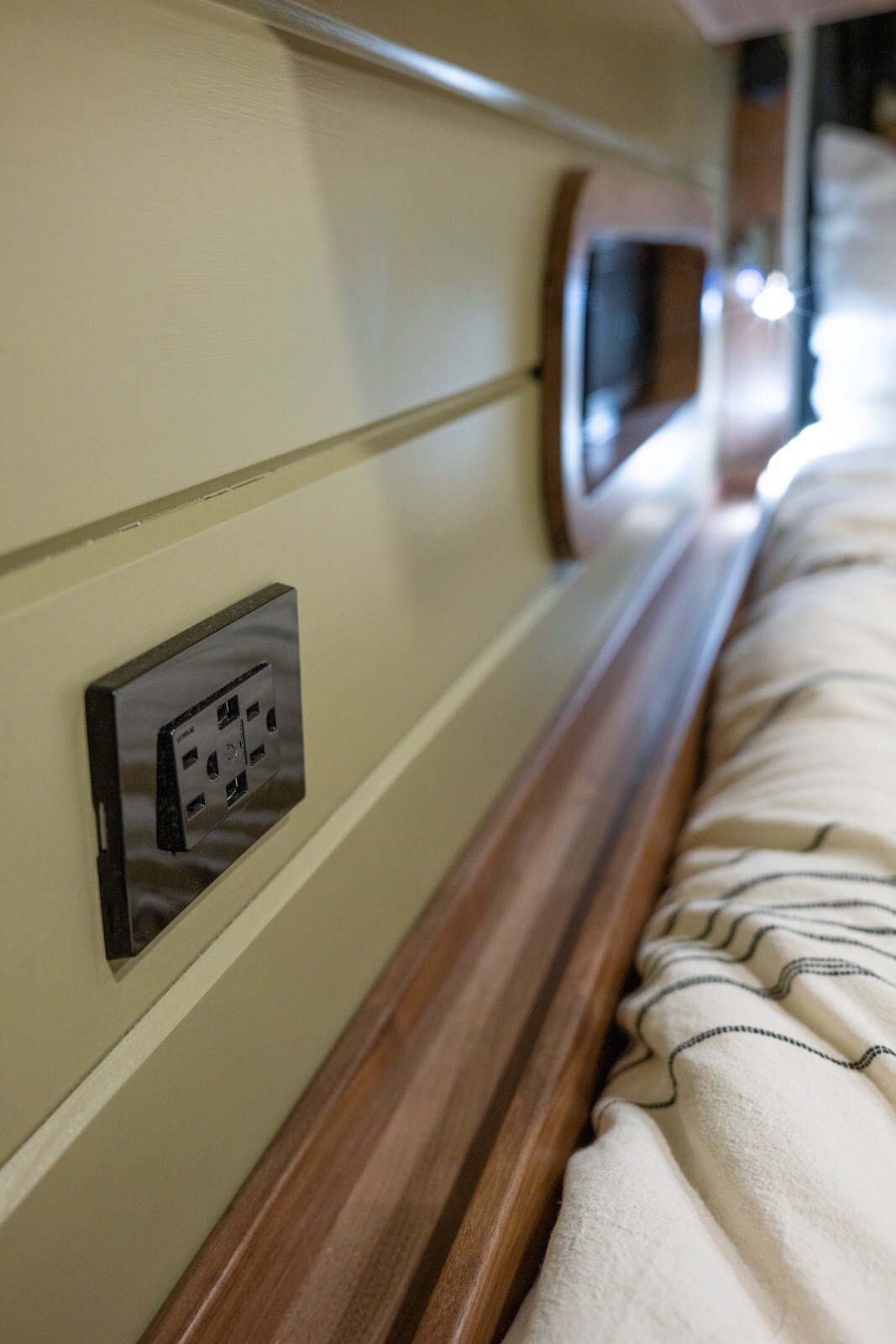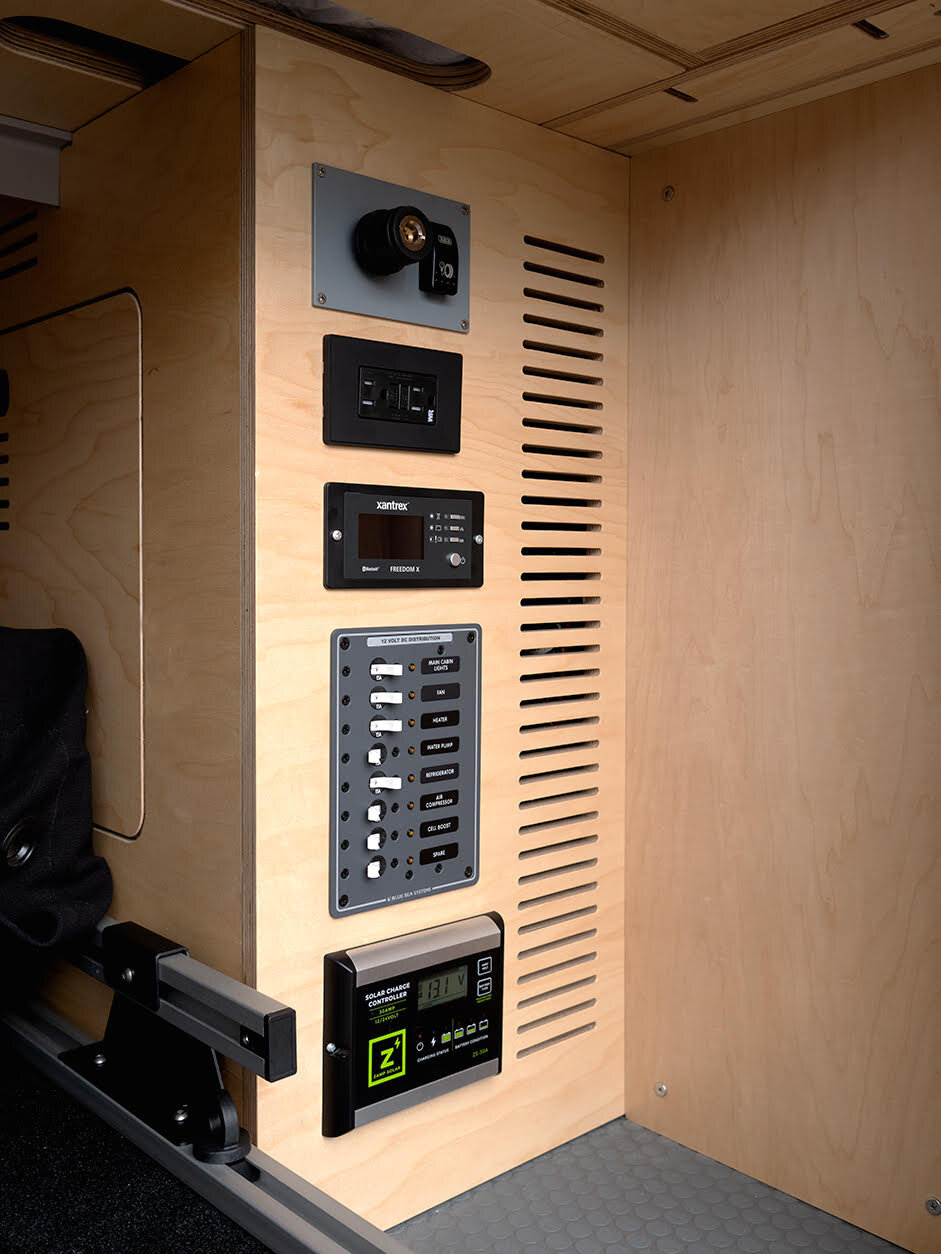The Truth About Campervan Electrical Systems
Photo credit: Muse & Co. Outdoors
Having a source of electricity is a big part of what sets #vanlife apart from just camping. The ability to charge devices, power lights, and even heat your van on cold nights are all made possible by your camper van’s electrical system. But the system has limitations, too. Unlike the electricity in your house, your campervan conversion’s off-grid electrical system is not connected to a constant and virtually limitless source of power.
A lot of people find Sprinter van electrical systems to be a confusing topic, but they don’t have to be. You don’t have to be an electrician to understand your camper van’s power system. In fact, many beginners build their own DIY campers and tackle the camper van electrics themselves! In this article, we’ll outline the basics of Sprinter van electrical systems, from how they work, to what they can and can’t do. Keep reading to learn more!
How Camper Van Electrical Systems Work: The Basics
Camper van electrical systems have three main parts: The power source, the charging source, and the loads. Any basic wiring diagram for a camper van electrical setup will show these three components. Below, we break down each of these electrical components and explain how they fit into the system as a whole:
Power Source
Camper van electrical systems are almost always 12-volt DC systems, so they use 12-volt DC batteries as their power source. The “leisure batteries” that are used to provide electricity in your van are similar to car “starter batteries”, but they are specifically designed for the type of use that is common in camper vans.
Photo credit: Muse & Co. Outdoors
There are different types of batteries available that are suitable for use in camper vans. They are all considered “deep cycle” batteries. Some of the most common battery types used in vans are lithium, GEL, and AGM batteries (lead acid). Each has some pros and cons, but lithium batteries are widely considered to be the best option, as they offer the longest lifespan and the most capacity. They are also the most expensive.
Batteries vary in how much electricity they store, and it is common in camper vans to use anywhere from one to four or more, depending on what size battery they use. Storage in camper van batteries is measured in “amp hours”. The more battery capacity you have, the longer you can use the electricity in your van before needing to recharge the batteries. You should install a battery monitor in your van to keep track of how much power you have remaining at any given time.
Your camper van will be considered a 12V system, because the batteries you have will provide 12V DC power. 12V DC is different from the 110 or 120V AC power that you can access through the outlets in your home. 12V DC is common in RVs, boats, camper vans, and more.
All this means is that the loads you hook up in your camper van, such as your lights, fridge, and fan, must be 12V appliances. Anything that is meant to plug into a home electrical outlet, such as your blender or computer charger, requires AC power. It is possible to provide AC power through outlets in a van, but there are limitations to what can be powered. We’ll cover this topic in more detail in the ‘Loads’ section.
Charging Source
Your batteries will power all the loads in your camper van, but as they do so, they become depleted. Unless you have a way to charge the batteries, you will run out of electricity in your van. You don’t have to have only one charging source for your batteries; you can use multiple sources to charge them faster and ensure you have a backup plan if one isn’t working
The three most common ways to charge camper van batteries are:
Solar panels: It’s rare to see a new camper van build these days without solar panels on the roof. Solar is a great way to charge your van’s batteries wherever the sun shines. Most camper van electrical systems can rely mainly or entirely on solar power to charge the batteries. Your solar system will also require a solar charge controller to be used for battery charging. The more solar panels you have, the faster they will charge your van’s batteries.
Alternator charging: Ever wonder how your car battery gets recharged? It does so using the vehicle’s alternator, which converts power from your engine into electricity to charge your car battery. Your Sprinter van has an alternator, and it can also be used to charge the auxiliary batteries that you use for camping. There are a few devices that can be installed to transfer power from your van’s alternator to your batteries, including split charge relays. All of them require the van to be running in order to charge, and will charge faster while you’re actually moving down the road.
Shore power: You can also charge your van batteries by ‘plugging them in’ to an outlet in a house or elsewhere, like at a campsite with electric hookups. To charge 12V batteries in this manner, you need an AC to DC battery charger, which is a common addition in camper vans. Then all you need is an extension cord, and you have a reliable charging source for your van batteries whenever you are in a driveway or at an RV park. It is also possible to bypass your van batteries when plugged into shore power (also called a “mains power supply”), meaning you can have outlets in your van that are powered directly from the grid. This allows you to run high-load appliances while plugged into shore power that you can’t use while camping off-grid, and it also lets you use the outlets in your van without draining your batteries.
Photo credit: Muse & Co. Outdoors
Loads
The loads of your camper van electrical system are all the things that you actually use in your van that require electricity. Common loads in a van include LED lights, a fan, a heater (which requires electricity to run but uses diesel or propane to actually provide heat), water pumps, a fridge, and 120V outlets for charging devices, etc.
Above, we mentioned that your camper van’s batteries provide 12V DC power. All of the appliances in your van, such as your lights and fridge, use 12V DC power - so they can simply be wired to the batteries to power them. If you want to charge devices and use small household appliances that plug into a regular household outlet, you need what’s called an inverter.
Inverters come in two main types, pure sine wave and modified sine wave. For most camper van systems, you’ll want a pure sine wave inverter as they can charge laptops without damaging them.
Inverters take the 12V DC power from your van’s batteries and convert it into 120V AC power, which is what comes through the outlets in your house. The main difference is that the outlets in your house are powered by the local power grid, which provides a virtually infinite source of electricity. The outlets in your van are powered by your batteries, which are a very limited source. This means that certain appliances just can’t be used in a camper van electrical system, because they drain the batteries too fast.
Inverters are useful for charging items like laptops and cell phones and powering small appliances like blenders.
Other Components
You charging source, batteries, and loads are the three main components in your camper van electrical system. But many other smaller components are also critical to making the system work.
The following smaller components are likely to be included in your van’s electrical setup:
fuse box
fuse holders
battery isolators
wire connectors
negative and positive bus bars
different wire gauges
Reality Check: The Limitations of Camper Van Electrical Systems
Having electricity in your van is a big part of what sets it apart from just camping. A fridge is so much better than a cooler, and overhead lights are infinitely nicer than a headlamp. But your entire camper van electrical system runs off of a handful (at a maximum) of batteries. As a camper van owner, you need to understand the limitations of your rig’s system to ensure that you don’t damage it or run out of electricity.
The two main mistakes that van owners make when it comes to their electrical systems are draining their batteries completely, and trying to use plug-in household appliances that require too much electricity. Every system is built to different specs and will be capable of handling different loads, so if you aren’t sure about what your van’s system is capable of, contact the builder.
In general, you can avoid issues with your camper van electrical system by monitoring the charge state of your batteries and avoiding the use of large household appliances. In certain situations, it might be necessary to go a bit out of your way to ensure that your van’s batteries stay charged. Examples include moving your van into the sun or taking a short drive if your batteries are low and you are relying on either solar or alternator charging.
Your inverter’s wattage rating will determine the maximum current you can draw through your van’s 120v AC electrical outlets when camping off-grid. But even if you are using an appliance that is below the maximum wattage allowed by your inverter, you can drain your batteries very quickly when using the 120v outlets. Certain appliances, such as space heaters, hot water kettles, and hair dryers, should be avoided entirely in camper vans. Your inverter won’t allow appliances over its maximum wattage rating to work, but you also shouldn’t run appliances near or at the limit for extended periods of time - because they will drain your batteries extremely quickly.
If you plan to have increased power needs in your van, you should talk to your builder about sizing up your system. The best way to accommodate a larger power draw is to add a larger battery bank. In certain scenarios, it may also be helpful to add greater charging capacity in the form of more solar panels or an alternator charger.
A Note About Air Conditioning
You may have seen camper vans that have a rooftop A/C unit installed. While there are A/C units available that run off of 12V DC power, it is highly impractical to build a camper van electrical system that is capable of running an A/C unit while camping off-grid. Most of the vans you see with A/C units are only able to use them when plugged into shore power.
The power draw of a rooftop air conditioner is simply too large to be accommodated by an off-grid camper van electrical system. The number of batteries and solar panels that would be needed to reliably use the A/C unit off-grid would take up an impractical amount of space in the van. If you plan on camping mainly at RV parks or in driveways where shore power is available, you could consider installing an A/C unit on your van’s roof.
We hope this article helped you clear up some of the most common questions about camper van electrical systems! To learn more about Muse & Co. Outdoors’ systems, head over to our details page. And, keep an eye out for our next post in this series, which will explain in detail what is included in our vans’ electrical systems, and what options are available to add on.



